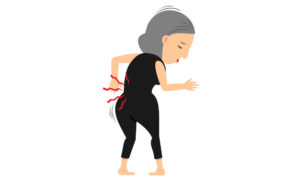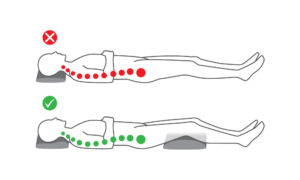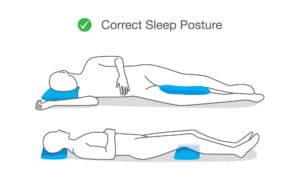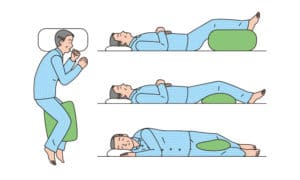Lower & Upper Back Pain After Sleeping: Understanding and Managing Morning Back Pain
, 7 months ago
Morning back pain is a common problem that almost everybody faces. An aching back during the morning will really be a bad way of starting the day, which entails discomfort and mobility limitations. It usually results from stiffness following lengthy rest or reduced blood flow resulting from sleep. Symptoms usually subside after one gets moving around. Early morning backache, though periodic to many, is more frequent among some people. Understanding the cause of this condition, the symptoms, and probable remedies will help you alleviate or avoid morning back pain.
Causes of Lower & Upper Back Pain After Sleeping
Morning back pain, whether it’s lower back pain or upper back pain after sleeping, is usually the result of several common factors. Understanding morning back pain causes can be understood to take measures toward preventing or managing it.
- Awkward Sleeping Positions and Bad Mattress: Poor sleeping positions can put additional strain on your back by pressing more than usual on the natural curve of your spine. An example is sleeping on your stomach, which arches and twists your back and neck, respectively, thus translating into back pain in the morning. A bad mattress might also be the culprit, particularly when the sleeping position is proper. A badly structured mattress allows the spine to sag into it rather than keeping it aligned and may also result in back stiffness by the time you wake up.
- Improper Lifting Technique: Improper lifting, bending, or even simply carrying heavy things can cause back pain. Lifting a heavy object without keeping the spine aligned may stress the back muscles beyond their normal and natural limits, thus causing lower back pain after sleeping.
- Inflammation: Spinal inflammation irritates the discs and nerves, hence leading to possible back stiffness upon waking. The inflammation could be due to an autoimmune disease, infection, or even something as simple as dietary and lifestyle factors.
- Overweight: There is a direct link between obesity and spine issues. Being overweight puts additional strain and pressure on the spine, which creates more vulnerability to back pain, especially in the morning.
- Smoking: Smokers are more likely to develop chronic back pain and spinal disc degeneration. This is because nicotine reduces blood flow to the discs, cushioning the vertebrae, and restricts nutrition supplies to them.
- Poor Posture and Muscle Overuse: Poor posture, like slouching, can weaken and decondition the muscles in your back, eventually leading to pain. Furthermore, overuse of the muscles in the back can be related to repetitive motion, muscle strain, tightness, and irritation of the muscles themselves.
- Accidents: Traumatic injuries from accidents, such as falls or sports collisions, can injure spinal bones, discs, muscles, ligaments, and nerves, leading to morning back pain.


Other Conditions That May Cause Lower & Upper Back Pain
Several conditions contribute to lower and upper back pain when one wakes up in the morning. These include infections, thoracic herniated discs, compression fractures, arthritis, fibromyalgia, severe spinal deformity, and vitamin D deficiency, which may have a predisposition to chronic pain. Age makes a person more likely to develop the problem due to already weakened core and back muscles, hormonal changes, and other musculoskeletal conditions. Women with different anatomy and variations in hormones might be more vulnerable to morning back pain.
Symptoms of Morning Back Pain
Since the causes of morning back pain differ, the symptoms differ, too. Here are some common symptoms:
- You may feel a kind of stiffness in the back, where it is difficult to move or even stretch it the next morning. This mostly loosens after some time as you walk around, but in some instances, this could persist throughout the day.
- The morning back pain that can range from a dull ache to sharp pain, affecting either the lower or upper back.
- Back pain is usually localized in specific areas of the back and may be accompanied by muscle tightness or spasms.
- Some people have a generalized ache in the back, which results from movement.
- Morning stiffness is often caused by inflammation or swelling of the back muscles or joints during the night.
- Dawn back pain is pain that starts early in the morning, often before you fully wake up. Several factors, including poor sleep posture and underlying medical conditions, can cause it.
Self-Care Measures for Your Lower & Upper Back Pain After Sleeping
While frustrating at times, lower and upper back pain can be relieved with several self-care methods that you can do to ease back discomfort:
- A change in sleeping position may significantly improve comfort upon waking up. Try to maintain your natural spine curve when you sleep. For most people, it is generally best to sleep on their back or side with their legs straight.
- Place pillows for support around your body: beneath the knees, in between the legs, and even under the lower abdomen, should you sleep on your stomach. This can keep your spine aligned and reduce morning back discomfort.
- Do the easy stretching every morning to release the compression that may have occurred at night. Stretch your arms over your head and reach your feet in the opposite direction to release tension in your back.
- If you feel that your mattress is leading to lower back pain causes after sleeping, you should change it. It is very important to use a mattress that supports the natural alignment of the spine in order to prevent back pain.
- Back pain can be relieved by applying heat or ice to the area that aches. Heat helps to relax tight muscles, and ice helps to reduce swelling.

Sleeping Positions to Prevent Lower & Upper Back Pain
Did you know that your sleeping position could play a huge role in whether or not you will have back pain in the morning? It is usually the result of low-grade inflammation, the major culprit being the strain due to an awkward sleeping position or use of the wrong pillow. Here are some tips that will help you avoid upper and lower back pain while sleeping:
- Use a Rounded Pillow for Your Neck: Sleep on your back with a contoured pillow under your neck to support the normal ‘S’ shape of your spine. This will help you avoid upper back pain causes after sleeping in the morning.
- Choose the Right Pillow Height: Your pillow should be high enough to support your neck but not at an uncomfortable height, making the head tilt at an unnatural angle. A flatter pillow under the head can do the work of keeping it aligned.
- Support Your Lower Back and Knees: Place a pillow under the curve of your lower back and under your knees when lying on your back to keep the spine in a neutral position; this may help reduce some morning back discomfort.
- Avoid Sleeping on Your Stomach: Sleeping on your stomach is tough on your spine because it arches your back and twists your neck, leading to back pain upon rising. If you must sleep on your stomach, use an extremely thin pillow or no pillow at all.

Lifestyle Changes to Reduce Lower & Upper Back Pain
Your lifestyle modifications also go a long way in managing and preventing both lower and upper back pains. Here are some lifestyle changes you can make to lower the risk of back pain:
- Rework Your Workstation: If you have to sit at your desk for hours each day, ensure your workspace is set up ergonomically. This means that your chair, desk, and computer screen must be correctly positioned to keep you in the right posture and avoid morning back stiffness.
- Establish a Regular Exercise Routine: Regular exercises help keep muscles of your upper and lower back strong and flexible. Focus on exercises that strengthen your core, shoulder blades, trapezius, and thoracic area.
- Maintain Neutral Spine Alignment While Sleeping: Avoid sleeping in positions that stress your back. As mentioned earlier, the back or side sleeping positions with appropriate support are best for preventing morning back pain.
- Manage Stress: High levels of stress raise the overall muscle tension and often worsen your back pain. Work to reduce your stress with meditation, deep breathing, or yoga. These can help bring your pain levels down.
- Quit Smoking: As discussed earlier, smoking can contribute to chronic back pain by reducing blood flow and nutrients to the spinal discs. Stopping this habit might help improve your overall health and even reduce the risk of experiencing back pain.
How to Prevent Lower & Upper Back Pain
In addition to exercises, following a consistent routine can help prevent lower and upper morning stiffness in the back:
- Warm up with light exercises before sleeping to loosen your muscles and sleep easily.
- Stretch before engaging in any physical activities that involve lifting heavy objects from the ground to avoid back strain and injury.
- If you have a job that involves long periods of sitting or standing, take regular breaks to stretch your neck and back.
- A mild massage to the back before sleeping may help soothe the muscles and relieve tension, thus making it easier to sleep without discomfort.
Conclusion
Most often, upper and lower back pain disappears within a week or two without doctor intervention. However, if you wake up every morning with intense pain in your upper back, which does not respond to various self-care techniques, then it’s probably the best time to consult a doctor. Severe pain, which has a sudden onset and worsens progressively over time, should be referred to a spine specialist or a physiotherapist. If there is associated back pain with numbness, tingling, or weakness of the arms, legs, or face, seek medical attention immediately; these can be warning signs of something more dangerous.





